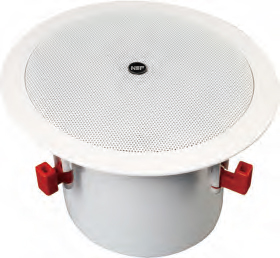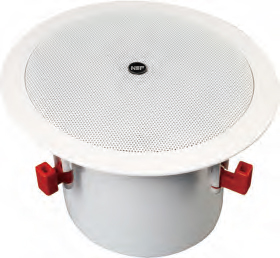How to Enhance Your Home Theater with Ceiling Speakers?
Creating an immersive home theater experience is every movie lover’s dream. While a high-quality screen and comfortable seating are essential, ceiling speakers can take your home entertainment to a whole new level. With their ability to provide a surround sound experience while remaining discreet, ceiling speakers are a game-changer for any home theater setup. In this guide, we’ll explore how to enhance your home theater with ceiling speakers, covering installation, placement, benefits, and more.

Why Choose Ceiling Speakers for Your Home Theater?
1. Immersive Surround Sound Experience
Unlike traditional floor-standing or bookshelf speakers, ceiling speakers create an overhead soundscape that makes movies, TV shows, and music feel more immersive. They distribute sound evenly, ensuring that every corner of your home theater is filled with crystal-clear audio.
2. Space-Saving and Aesthetic Appeal
One of the biggest advantages of ceiling speakers is their space-saving design. Since they are installed in the ceiling, they eliminate the need for bulky floor speakers, keeping your home theater setup clean and organized.
3. Customizable Audio Experience
Many ceiling speakers offer adjustable tweeters and directional sound capabilities, allowing you to tailor the audio experience to your liking. You can position them to optimize sound projection and create a more realistic surround sound effect.
How to Choose the Right Ceiling Speakers for Your Home Theater
1. Consider Speaker Size and Power
When selecting ceiling speakers, size and power play a crucial role. Larger speakers (8-inch drivers) offer deeper bass, while smaller speakers (6.5-inch drivers) provide clear mids and highs. Choose speakers with sufficient wattage to match your home theater’s amplifier.
2. Match Speakers with Your AV Receiver
Ensure your ceiling speakers are compatible with your AV receiver. Look for impedance and power ratings that match your receiver to achieve optimal performance without distortion.
3. Choose Between Mono and Stereo Speakers
For a home theater, installing mono ceiling speakers in a surround sound setup is ideal. Stereo speakers, which produce both left and right channel audio from a single unit, are more suited for smaller rooms or general background music.
4. Look for High-Quality Speaker Materials
Speakers made with premium materials like Kevlar woofers and titanium tweeters provide superior sound quality and durability. Investing in high-end ceiling speakers ensures longevity and better performance.
Where to Place Ceiling Speakers for the Best Home Theater Experience?
1. Ideal Speaker Placement for Surround Sound
To create an effective surround sound experience, position your ceiling speakers in a strategic layout:
- Front Speakers: Place two ceiling speakers slightly in front of the seating area, angled toward the listeners.
- Surround Speakers: Install speakers behind or to the side of the seating area to provide depth and realism.
- Atmos Speakers: If you want a Dolby Atmos setup, place additional ceiling speakers directly above the seating area for overhead effects.
2. Consider Speaker Distance and Angling
For optimal sound dispersion, maintain a distance of at least 6-8 feet between each ceiling speaker. Angling the tweeters towards the listening position can enhance sound clarity and create a more focused audio experience.
How to Install Ceiling Speakers in Your Home Theater?
1. Gather the Necessary Tools
Before installing ceiling speakers, ensure you have the following tools:
- Drill and hole saw
- Speaker wire
- Wire stripper
- Screwdriver
- Measuring tape
2. Locate and Mark Speaker Positions
Use a stud finder to avoid beams and mark the spots where you’ll install your ceiling speakers. Make sure the placement aligns with your home theater’s surround sound configuration.
3. Cut the Speaker Holes
Use a hole saw or drywall saw to cut the ceiling according to the speaker template provided by the manufacturer.
4. Run the Speaker Wires
Route the speaker wires from the AV receiver to each ceiling speaker location. If your home theater is already built, consider using fish tape to guide the wires through the ceiling.
5. Secure and Connect the Speakers
Insert the ceiling speakers into the cutouts, connect the wires, and secure them in place using the provided clamps or brackets. Ensure a tight connection for optimal performance.
6. Test and Fine-Tune Audio Settings
Once installed, power on your AV receiver and test the ceiling speakers. Adjust the equalizer settings and speaker levels to achieve the best sound quality.
Enhancing Sound Quality with Ceiling Speakers
1. Pair Ceiling Speakers with a Subwoofer
Since ceiling speakers may lack deep bass, adding a subwoofer enhances low-frequency performance, creating a more cinematic sound experience.
2. Use Acoustic Treatments
Minimize sound distortion by adding carpets, curtains, and acoustic panels to your home theater. These materials help absorb excess sound reflections and improve overall audio clarity.
3. Optimize AV Receiver Settings
Most modern AV receivers offer calibration tools like Audyssey or YPAO, which adjust audio levels automatically. Use these features to fine-tune your ceiling speakers for the best performance.
Best Ceiling Speakers for Home Theater Systems
1. Klipsch CDT-5800-C II
Known for its high-quality sound and pivoting tweeters, this ceiling speaker delivers crisp highs and deep bass.
2. Polk Audio RC80i
A budget-friendly option with great sound clarity and moisture-resistant materials, making it perfect for multiple room applications.
3. Yamaha NSIC800WH
Offers a balanced sound profile with easy installation, ideal for home theater setups.
4. Bose Virtually Invisible 791 II
Provides immersive surround sound with a sleek, nearly invisible design.
Common Mistakes to Avoid When Using Ceiling Speakers
1. Incorrect Speaker Placement
Placing ceiling speakers too close or too far apart can create uneven sound distribution. Follow recommended placement guidelines for the best results.
2. Using Low-Quality Speaker Wire
Thin or poor-quality wires can affect sound clarity. Use at least 16-gauge or 14-gauge speaker wire for optimal performance.
3. Ignoring Room Acoustics
Hard surfaces can cause sound reflections that lead to echoes. Use soft furnishings and acoustic treatments to improve sound quality.
Enhance Your Home Theater with Ceiling Speakers
Investing in ceiling speakers is one of the best ways to elevate your home theater experience. They provide immersive surround sound, save space, and blend seamlessly with your home decor. By choosing the right ceiling speakers, placing them strategically, and optimizing your setup, you can transform your living space into a true cinematic paradise. Whether you’re watching action-packed movies or enjoying your favorite music, ceiling speakers will ensure that every sound detail is delivered with precision and clarity.
Now that you know how to enhance your home theater with ceiling speakers, it’s time to upgrade your sound system and enjoy a next-level entertainment experience!
